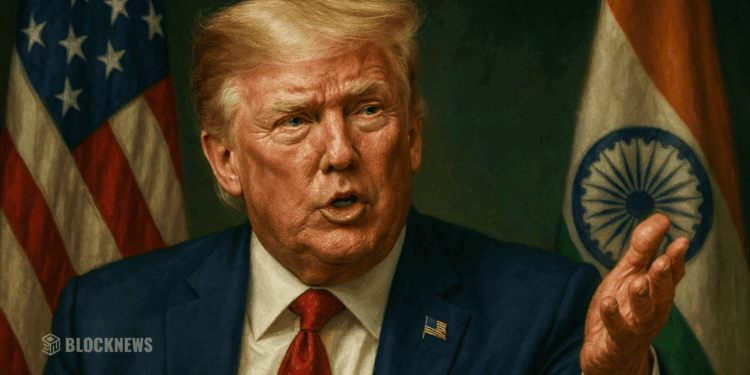- Trump called India-US trade a “one-sided disaster,” citing a $46B trade gap and India’s oil ties with Russia.
- US tariffs on Indian goods have doubled to 50%, hitting key sectors like textiles, gems, footwear, and seafood.
- Forecasts suggest India’s exports to the US could plunge to $50B by 2026, cutting 1% from GDP and costing jobs.
The trade battle between the US and India just got hotter. On Monday, President Donald Trump blasted the India-US trade equation, calling it a “one-sided disaster.” He went further, claiming India had offered to slash tariffs on American imports down to “nothing” — but, in his words, “it’s getting late” for that kind of deal now.
Trump’s frustration wasn’t just about the gap in trade. Once again, he pointed toward India’s ties with Russia, especially its oil purchases, framing them as an indirect way of helping Moscow fund the war in Ukraine. His administration already slapped a 25% penalty tariff earlier in the month, and now it’s doubled down with a steep 50% rate on most Indian goods.
US Pushback, India Pushback
The comments come amid stalled trade talks. Treasury Secretary Scott Bessent recently flagged the slow progress, while Trump’s top aides have hurled sharp criticism — even accusing Indian refiners of “profiteering” on cheap Russian oil. For its part, India has pushed back, defending its position and protecting sensitive sectors like agriculture from what it sees as unfair US pressure.
Indian Prime Minister Narendra Modi, meanwhile, has been strengthening ties in Asia, making trips to Japan, China, and reaffirming the decades-long bond with Russia. It’s a not-so-subtle sign of how global alliances are shifting at a time of trade turbulence.
The Trade Gap and the Tariff Fallout
Trump’s argument is simple: India sells far more to the US than it buys. In 2024, India exported $87.3 billion to America, while importing just $41.5 billion — a surplus of nearly $46 billion. For the first half of 2025, exports have already topped $56 billion, while imports sat at just $22 billion.
Those numbers, Trump insists, show why US businesses can’t compete in India. But beyond the rhetoric, the tariffs are already starting to sting. Labour-heavy industries like textiles, gems and jewellery, footwear, and seafood are most exposed. Pharmaceuticals and electronics have been spared, at least for now.
What Could Happen Next?
Economists warn that the tariffs could cause Indian exports to the US to tumble from $87 billion in 2024 to closer to $50 billion by 2026. That drop could shave around 1% off India’s GDP and hit jobs hard in export-heavy sectors.
Trump, however, seems determined to keep pressure on. “They should have done so years ago,” he posted, referencing India’s alleged offer to cut tariffs. For now, the trade drama looks far from over, and both sides appear ready to dig in for a long fight.














